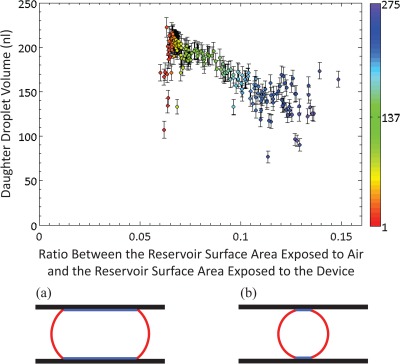Figure 6.
Daughter droplet volume plotted as a function of the ratio between the exposed surface area of the reservoir and the area of the reservoir in contact with the hydrophobic device surface. The exposed to contact surface areas ratio is used as a measure of the energy of the droplet. At high ratios, the reservoir sits in a lower energy configuration and, therefore, adopts a more spherical shape. Hence, droplet dispensing is harder and daughter droplets are smaller. The colour scale represents the droplet number, with red being the first daughter droplet dispensed and purple being the last. (a) and (b) show the high and low energy configurations of the reservoir, respectively. The red lines denote the surface of the droplet that is exposed and the blue lines denote the surface of the droplet that is in contact with the device. To calculate the surface area of the reservoir that is exposed to air, the length the curved boundary region of the reservoir is first determined. This is the arc segment that encloses A2 in Figure 3b (length = 2 * γ * (π/180) * R). Secondly, the reservoir perimeter is calculated by dividing the single pixel area by the pixel size. The reservoir surface area exposed to air is calculated by multiplying the length of the curved boundary region by the reservoir perimeter.

